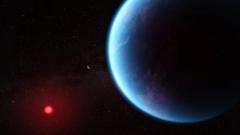A team of astronomers from Cambridge University has made a significant breakthrough in the search for extraterrestrial life, as they report tentative findings of life-related molecules in the atmosphere of a distant planet named K2-18b. By analyzing data from NASA's James Webb Space Telescope (JWST), the team has identified signs of molecules typically produced by simple life forms on Earth.
This groundbreaking revelation marks the second occasion that such life-associated chemicals have been observed in the planet's atmosphere. The lead researcher, Professor Nikku Madhusudhan, expressed optimism about confirming these findings within the next one to two years. "This is the strongest evidence yet that there is possibly life out there," he stated confidently.
K2-18b, located an astounding 700 trillion miles away from Earth and approximately two and a half times larger than our planet, has intrigued scientists for its potential habitability. The JWST’s advanced capabilities allow for chemical analysis of exoplanet atmospheres through the light filtered from their host stars. The Cambridge group is specifically investigating the presence of dimethyl sulphide (DMS) and dimethyl disulphide (DMDS), gases produced by marine phytoplankton and bacteria on Earth.
During the observations, researchers noted an unexpected abundance of these gases, leading Professor Madhusudhan to remark, "The amount we estimate of this gas in the atmosphere is thousands of times higher than what we have on Earth." If these findings are corroborated, it could suggest that K2-18b hosts a rich tapestry of life.
Despite these promising developments, the scientific community underscores the necessity of additional data before definitive conclusions can be reached. Current results, while significant—boasting a confidence level of 99.7%—fall short of the five-sigma threshold needed for a solid discovery claim. Professor Catherine Heymans from Edinburgh University cautioned that even with further verification, the origin of the detected gases remains uncertain—whether they are biological or produced by non-living geological processes.
The Cambridge team is actively investigating whether DMS and DMDS can arise from inorganic methods in laboratory settings, amidst competing hypotheses regarding the planet’s formation and environmental conditions. Some scientists speculate that the absence of ammonia in K2-18b’s atmosphere may indicate a vast ocean beneath its surface, while others propose potential volcanic activity or classify it as a mini gas giant without a solid surface.
Professor Oliver Shorttle and Dr. Nicolas Wogan voiced differing interpretations, contributing to the vibrant scientific discourse surrounding K2-18b. Despite these challenges, Professor Madhusudhan remains hopeful, asserting that the ongoing research could pave the way for answering the profound question of life's existence beyond Earth.
The findings have been documented in the recent edition of The Astrophysical Journal Letters, signaling a significant step forward in the quest to uncover whether we are indeed alone in the universe.







